Your location: Rideau Canal Home Page > Behind the Scenes > Emergency Repairs
 Emergency Repairs - A Tale of Two Sills Emergency Repairs - A Tale of Two Sills
While regular maintenance of the Rideau Canal prevents many problems, unexpected problems do occur. In 2005 the Clowes lock and the Ottawa locks had to be briefly shut down for emergency repairs. Time is of the essence to get the canal back in operation and the engineering teams scrambled to identify the problem and implement a solution. In both cases it was a job well and quickly done. This is their story:
|
Clowes Lock Repair
by Bill Pratt - Asset Management and Construction Engineer, Rideau Canal
Thought I would take a little time and inform you all of the events that
occurred at
Clowes Lockstation last week.
Tuesday [July 5, 2005], late in the morning, Gerald Covell phoned Rideau Engineering
identifying
a serious "muddy boil" downstream of their Lower Gates. The water flow
feeding the
"boil" made operation of the Upper Gates extremely difficult. Upon
inspection,
Engineering immediately called in a dive team in the hopes of finding an
entrance
hole in, or near, the upstream side of the Gate Sill. Kanata Diving
arrived at the site
within two hours but were unable to find any sizeable void. That evening
it was
decided that, even though it was July, Clowes would have to be closed and
Dewatered.
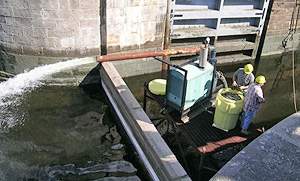 |
| Dewatering the Lock |
photo by: Bill Pratt |
Wednesday 7:00 am, Clowes Lower Reach was lowered; Shops Dewatered the Lock
and; Engineering and Central Sector Maintenance/Operational Staff readied
equipment
and ordered material in anticipation of repairing the Timber Sill and/or
grouting its stone,
mortar , reinforced concrete and bedrock sublayers (circa 1988). During
the inspection
of the Sill late Wednesday evening: 1) a fair size exit hole was found in
the Sill (cause
of the boil), and 2) it was also discovered that the plates and nuts on
top of the existing
Sill anchors had failed allowing the Sill to lift by as much as 3 1/2" in
places. The lifting of
the Sill greatly complicated repairs.
Thursday 7:00 am, our own Luc Beriault of PWGSC was called in to design new
anchors to
stabilize the Sill against further lifting; Shops re-established as best
they could the metal plates on
top of the existing anchors and; Engineering hustled to find new anchors
that hopefully could be
delivered and installed the following day and, with Shops & Central Sector
Crews, pumped grout
into the voids in the stone, mortar and concrete components of the Sill.
The operation finished
around 8:00 pm.
Friday 7:00 am, Capital Cutting and Coring of Ottawa along with Shops and
Sector Staff cored the
holes for the new Sill anchors; the anchors arrived from London, Ontario
(overnight delivery) and
were installed, post-tensioned and grouted by 7:00 pm. Clowes Lower Reach
was partially raised
during the night in preparation for Navigation Saturday morning. The Lock
was kept Dewatered
overnight to allow the grout to set up.
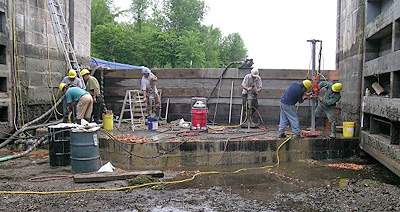 |
| Repairing the Sill |
photo by: Bill Pratt |
Saturday 6:00 am, Shops and Sector Crews arrived on site in the rain to
flood the Lock. Unfortunately,
the raising of the Lower Reach overnight also inadvertently raised the
water in the Lock and Crews
had to work in rain and waist deep water to remove sand bags and pumps from
the Lock. At around
9:50 am the Lower Reach was back to Navigation levels and the Lock was
reopened.
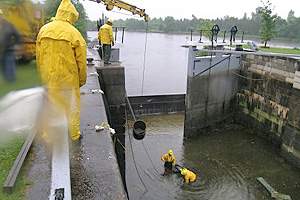 |
| Removing the Sandbags |
photo by: Bill Pratt |
It was not as easy as it sounds above. This was a "scramble project";
plans and scheduling were
made on the fly with no field investigations to guide us, material and
equipment that had to be
delivered within short time frames were difficult to find, people became
tired from working 13 plus
hour days, bits and other smaller equipment broke and needed repair, the
weather was hot.
While Staff were dealing with the technical issues at Clowes, other Rideau
Canal Staff were dealing
with Visitor issues. Examples were: Boaters were chauffeured to town by
Lock and Woods Mill Staff,
one child who had an allergic reaction to peanuts was rushed to the
emergency ward in Kemptville,
some boaters were provided with temporary power supply.
Projects like this aren't accomplished by everyone just doing their job, it
takes an extraordinary effort.
Congratulations to all. Last week was our chance to shine - and we did.
It was good working with you. Thanks for your efforts.
Bill Pratt
Ottawa Locks Repair
by Joe Brown, Chief Engineer, Rideau Canal
Again we have had to call upon the troops to save the day. Rideau Canal employees have come together to complete an emergency repair on a gate sill at Ottawa Locks in record time.
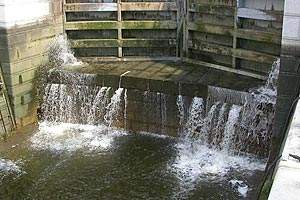 |
| Leaking Sill |
photo by: James Scarlett |
Significant leakage had been recently observed through the sill between Locks 7 and 8. As well as, there was obvious movement of the top course of the masonry sill. The condition of the sill continued to worsen until mid last week when it was determined that corrective action had to be taken. On Thursday, August 11, 2005, work started on mobilizing for the repair. That evening, the locks were closed to navigation. On Friday afternoon, work started on the repair. A drilling contractor worked until late Friday and again on Saturday drilling 14 vertical 2 inch diameter by 10-feet deep holes into the sill to install grouted rock anchors. Rideau Canal Headquarters Shops, Northern Sector Maintenance, the Operations employees at Ottawa Locks and Andy Moore from Central Sector Operations worked extremely hard and continuously all day Saturday to install and grout the anchors.
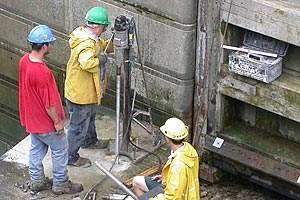 |
| Drilling the Sill |
photo by: James Scarlett |
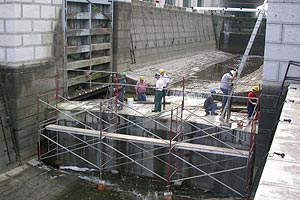 |
| Repairing the Sill |
photo by: James Scarlett |
As usual with these emergency jobs, everything did not go as planned. The core drilling operation indicated that the original stone masonry forming the core of the sill to be very weak and fractured. Due to the poor condition of the rock, we were unable to set and torque many of the mechanical rock anchors. As well, in an effort to minimize the length of the interruption to navigation, I mixed the grout quite thick. This made it very difficult to pump the grout into the holes to consolidate the anchors. With the mechanical anchors not holding and little grout getting into the holes, the anchors would be ineffective and we would have failed to improve the stability of the sill. We needed a way of filling the holes with grout.
Magically, a 10-foot long piece of plastic pipe with a large funnel secured to one end suddenly appeared on the site. Our maintenance guys had done it again. Using this device, we could now pour the thick grout down into the holes and be assured that the holes were full of grout before placing the anchor rods. Due to the failure of a number of the mechanical anchors, we would now have to depend solely upon the grout for these anchors to be effective. As it turned out we were able to set and torque over half of the anchors. The grout was given 38 hours to develop strength and the locks were open to navigation first thing Monday morning.
On Wednesday, the elevation of the sill was surveyed both with full hydrostatic load and no load. No deflection was found indicating the anchors are holding. We will continue to monitor the sill periodically to the end of the current navigation season. We are now working on plans to reconstruct the sill after navigation this year.
I would like to thank everyone involved in this project for their hard work, valuable input and cooperation. Everyone was super.
Joe Brown
Chief Engineer, Rideau Canal
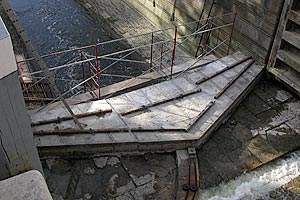 |
| Repaired Sill |
photo by: James Scarlett |
|
Comments: send me email: Ken Watson
©1996- Ken W. Watson
|